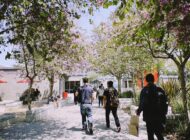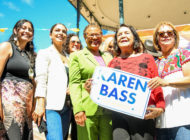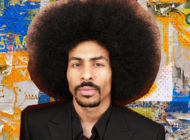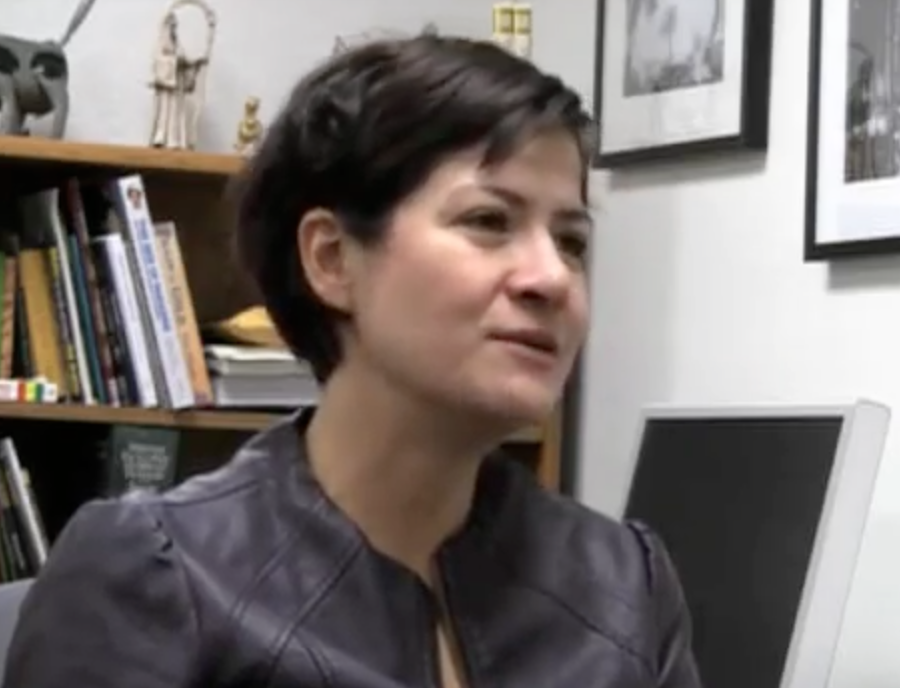
Bus riders on the Orange line operating from Chatsworth to North Hollywood Station. A majority of people commuting on bus is people of color, according to The Bus Riders Union. (Photo: Seva Grigoraki / El Nuevo Sol)
BY SEVA GRIGORAKI
EL NUEVO SOL
The structure of Los Angeles’ transportation system has a complex history of economic, social and environmental issues and events. The amount of cars, asphalt and 350 miles of highways along with winding freeways seem incessant.
“The city was never envisioned becoming this large,” said Steve Graves, associate professor of geography at California State University, Northridge. “They set up the transportation system to be car friendly, but at that time there wasn’t 9 million people. At that point, the car made a lot of sense with ease and comfort, and it was inexpensive back then in 1940.”
Until 1940, Los Angeles had a decent public transportation system consisting of trolleys better known as Red Cars. During the 1940s, the city sold off its system to private corporations that were supposed to renovate and improve the Red Cars. These private corporations eventually condemned the Red Cars and instead implemented an automobile-friendly transportation system. Strangely enough, the corporations developed the public systems so they coincidently applied to the companies’ own interests. In regard to this story, there exists a myth known as the General Motors Conspiracy Legend. True or not Los Angeles today is highly dependent on the roads in terms of getting around.
Dependency on Public Transportation
According to the California Department of Motor Vehicles and the US census 2011 L.A. County has around 7.5 million registered vehicles and an estimated population of 9.8 million people. According to the U.S. census, 69.8 percent of Angelenos commute alone in their car and another 10 percent carpool. Only 10 percent use public transportation for commuting to work, which seems like a small percentage. But in a city with nearly 10 million people, this equals a massive amount of individuals who depend on the efficiency of public transportation every single day.
Chantal Coudoux, a D.C.-based policy advocate at The Bus Riders Union (BRU), describes how 92 percent of the people riding the bus are overwhelmingly working-class people of color making less than $14,000 per year.
“The bus is literally folks’ way to get to the hospital, to a doctor appointment, to get their kids to school, to get to work, to look for work,” Coudoux said. “It is people’s lifeline to get to everything.”
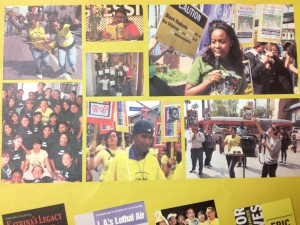
Picture collage from the Bus Riders Union Strategy Center, Los Angeles. (Photo: Seva Grigoraki/El Nuevo Sol)
In 1996, the BRU, a community-based organization fighting for civil right and environmental justice, won a lawsuit against the Metropolitan Transportation Authority (MTA), which is a $4 billion agency that controls and operates the majority of the bus and rail systems in Los Angeles. The odds were not in BRU’s favor, but it won the lawsuit, which was a huge victory for the communities depending on the buses. What came out of it was a 10-year consent decree, which is a legally binding agreement between the BRU and the MTA.
“By certain years, MTA had to put out a certain amount of buses in the streets with a certain amount of service and not being able to eliminate the monthly pass,” Coudoux said.
Coudoux also explained how the red buses of the Rapid Bus System, which makes less frequent stops, were a product of the consent decree. Five hundred new buses were put out, and they represented the nation’s largest clean-air fleet, because they went from using diesel fuel to compressed natural gas, which was the cleanest form of energy in 1994.
According to the census, Los Angeles has more natural gas-powered buses than any other city in the United States. Steve Spears, a Ph.D. candidate at University of California, Irvine and engineer, explained in a METRANS seminar at USC how the AB 32 regulations set limits on greenhouse gas emissions from ground transportation and try to seek out reductions. The goal for Los Angeles County is to achieve an eight percent greenhouse gas reduction by 2020, compared to 2005 and a 13 percent reduction by 2035. The metro public planning organizations are responsible for putting together a sustainable community strategy for meeting these targets.
Don’t Pay for Racism
“Don’t pay for racism,” was a slogan that the BRU came up with meaning that people should not pay for the terrible conditions inside public buses.
Bus rider Michael Divo said the worst thing about the public transportation system is that it is crowded and takes too long . “The buses should stop less frequently and there should be more of them,” Divo said.
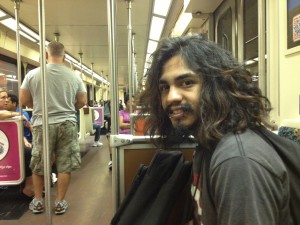
Michael Divo, student at Musicians Institute located in Hollywood, commutes everyday by bus and train. (Photo: Seva Grigoraki/El Nuevo Sol)
“The bus system is easy to use when you know the schedules,” said another bus rider, Joanna Ramírez. However, she also said she was inconvenienced when the MTA shut down a line she had used before and was forced to change her route.
Most bus riders agree that the bus system is much less efficient than the rail system. If you look at the rail system, it shows how richer and wealthier areas of Los Angeles tend to have access to a sufficient train system, whereas lower income and suburban areas depend on the bus system because there are, simply, no railways serving these areas.
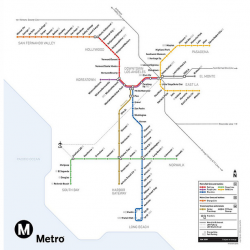
Metro rail map shows the circulation of the trains in L.A. County (Photo: Seva Grigoraki/ El Nuevo Sol)
“Although ambitious, the proposed $4.1 billion budget driving this progress has been balanced without layoffs or increases in Metro bus and rail fares, already among the lowest of any major transit carrier. Moreover, service quality as measured by on time performance, cleanliness and reliability will be improved,” writes MTA CEO Arthur T. Leahy in the fiscal year report 2012. The report states that sixty percent of the budget will be devoted to enhancing the Metro bus and rail system, including completing previously deferred maintenance that resulted from the need to mitigate deficits in prior years.
“Metro will also be purchasing hundreds of new buses and light rail vehicles and investing in such major bus improvements as an extension of the Metro Orange Line busway to Chatsworth,” Leahy says.
But Coudoux argues that the MTA isn’t using that money efficiently.

Joanna Ramírez uses the Metro bus system everyday. “The bus system is easy to use when you know the schedules,” she says. ( Photo: Seva Grigoraki/El Nuevo Sol )
“MTA has cut a million hours of bus service, so it is quite clear that they are not putting their resources toward the bus system, which is 80 percent of the ridership of both the trains and the buses. Bus is the main source of transportation for transit-dependent people in Los Angeles,” she says.
Racial Segregation of the Transport System
Another critical aspect of MTA’s discourse is that it gives very large contracts to rail companies such as construction, management and engineering firms, which can be seen as corporate welfare as in the case with the General Motors myth. These corporations work for a transportation system serving the richer ridership in wealthier areas of Los Angeles, who are not the people getting out of their cars and using the trains. Instead of improving the systems simultaneously, there seems to have been a main investment in train service and a cut in bus service.
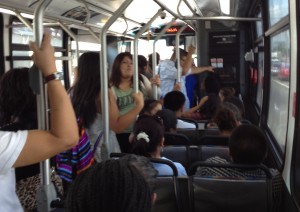
Busline 353 on the way from Northridge to Panorama City. The buses are often overcrowded and it is hard to have a seat. (Photo: Seva Grigoraki/El Nuevo Sol)
One example of this is the $930 million Expo Line project, which resulted in several surrounding bus lines having their hours cut or being shut down. For example, people who used to take bus 305 from South Los Angeles to the University of California, Los Angeles, now have to take two or three buses, because the Expo Line does not go to UCLA.
Greener Ways of Transportation
If we take a look at Western Europe we will find that the practice of biking is a normal way of commuting to work.
Dave Horton from the Institute of Environment, Philosophy and Policy Planning at Lancaster University, explains how the bike not only has played a major role within oppositional cultures of various social movements as a symbol of equality, green visions and environmental justice, but also how the bike has become a popular, sustainable, green, environmental-friendly solution for getting around. It is as normal to commute by bike, as it is to go by car, bus or train. Furthermore, driving a bike is much cheaper than having a car and it also provides you with your daily amount of exercise.
However, less than one percent of all angelenos prefer to use the bike for commuting to work. According to Horton, the car is a privatized capsule inhabiting public space. For the driver, the urban space becomes an unfamiliar environment, whereas the car provides a safe, familiar, cocoon-like inside space. Further more, biking has not been adapted by the citizens as being a normal phenomena. For example one could ask if it would become more likely to ride a bike to work if it became the norm to do so?
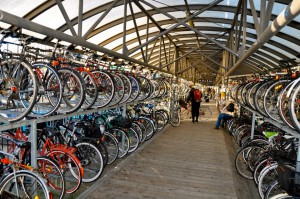
Bicyclists in Copenhagen, Denmark. With a population of 1.1 million and 36 percent of people commuting to work by bicycle, makes more people commute, by bicycle in greater Copenhagen than in the entire United States. (Photo: Sigrid Risager Thomsen)
Eric Bruins from Los Angeles County Bicycle Coalition said he wishes to see biking become a normal thing.
“It is interesting that at places where biking is very frequent people don’t identify themselves as bicyclists,” Bruins said. “Here in the United States, if you ride a bike you identify yourself as a bicyclist, because you feel like an outcast and like a minority group. And all it is just riding a bike. It is just a normal thing that normal people do.”
Means of a Greener System
According to Graves, “If there was sufficient public transportation in Los Angeles, it would be great. People could drive their cars less frequently and maybe not even own a car, because that is the way lots of people live in New York or Chicago, San Francisco. They all have efficient public transportation systems. People would not have to pay for expensive cars; the air quality would be a lot better because of the reduced amount of cars. Those people still driving would find the highway less crowded and therefore they could go from place to place more quickly, which would further reduce pollution because cars wouldn’t be stuck in long lanes creating smog.”
Click for Interactive storyline of Los Angeles transport history
-Seva Grigoraki
——————————————————————————————————————
Featured stories:
A Project for Green America
Methods of Transportation that Benefits your Pockets and the Environment
Realizing pollution: Getting beyond the limits of our five senses
Cruise Control: helpful for the environment and your pocket
Reduce your dependency on oil today !
How can you help climate control ?
The Healthcare Crisis in the United States
Tags: AB 32 Bikes biking la BRU civil rights CSUN environmentalism Expo line freedom green visions Grigoraki LA Los Angeles Los angeles county bicycle coalition Metrans MTA People racism Railways Rapid Bus System Red Cars rights Seva transportation urban planning











